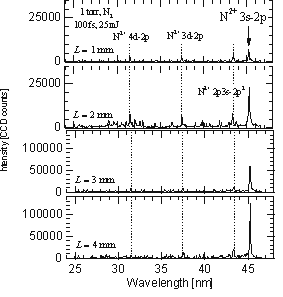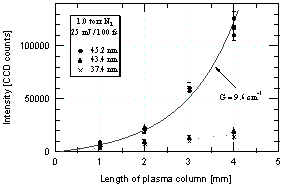
Soft X-ray Laser with Low Pumping Energy
Hidetoshi Nakano, Peixiang Lu, Tadashi
Nishikawa, and Naoshi Uesugi
Physical Science Laboratory
@Since the first report on laser amplification
in soft x-ray regime in 1985, great progress has been achieved in the field of
x-ray lasers based on mainly laser facilities with huge size. Recent
developments in ultrafast laser technologies opened a new trend toward table-top
sized x-ray lasers. Realizing a table-top size x-ray laser is important for
practical applications. One of the most promising ways of developing table-top
x-ray lasers is based on optical-field induced ionization of atoms in an intense
laser field provided by high-power femtosecond laser systems. We have
successively demonstrated a gain at 45.2 nm using a transition in boron-like
nitrogen ions by an only 25-mJ linearly polarized 100-fs laser pulse.
@The experiments were carried out using a
T3(table-top tera-watt)-laser system. The 100-fs, 790-nm linearly polarized
laser pulse was passed through a 2-inch-diameter, 5-mm-thick MgF2 widow into a
vacuum chamber, and was focused by a 400-mm focal length MgF2 lens into a
differentially pumped nitrogen gas cell. The gas cell had pinholes (< 500 Êm)
at both ends where the laser light passed through. Line-shaped plasma was
created along the propagating direction of the laser light. Figure 1 shows the
axial emission spectra observed at a fixed gas pressure of 1 Torr and pumping
laser energy of 25 mJ for different plasma lengths L. From the figure, the NIII
3s-2p lasing line at 45.2 nm dominates the spectrum at long L. In Fig. 2, line
intensity at 45.2 nm is plotted as a function of the length of plasma column.
From this figure, we obtained a small signal gain coefficient G and a
gain-length product GL as 9.6 cm-1 and 3.84, respectively.
@

Fig. 1: Axial soft x-ray emission spectra of the line-shaped nitrogen plasmas for different lengths.

Fig. 2: Time-integrated intensity of NIII lines as a function of line-shaped plasma length.